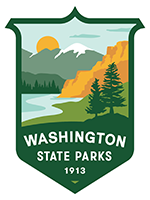Search results
1011 results found
Illahee State Park takes its name from the Chinook jargon word for “homeland.” The park lies within the traditional territories of Coast Salish Indigenous people whose present-day descendants include members of the Suquamish Tribe. Indigenous historian Vi Hilbert noted that today’s park occupies a site known as Xitca’sEb, meaning “to feel a tremor.” Geologists have mapped two main faults of the Seattle Fault Zone running north and south of the park area. The fault zone was the site of a major earthquake 1,100 years ago.
Lake Sammamish State Park is one of Washington’s most popular state parks, attracting visitors from the large cities and towns nearby with its attractive beaches, picnic areas, athletic fields and open space.
Tongues of the great Pleistocene glaciers that excavated the passageways of Puget Sound also dug the nearly seven-mile-long basin of Lake Sammamish. Today’s park encompasses the floodplains of Issaquah Creek and Tibbetts Creek at the lake’s inlet.
OLYMPIA — The Washington State Parks and Recreation Commission will hold its regular commission meeting on Oct. 16 at its headquarters in Lacey.
The public is welcome to attend in-person or online.
Agenda items include:
Two of Washington’s great rivers converge at Wenatchee Confluence State Park. This place connects different geologic terranes, Indigenous nations, fruit growers, packers and distributors, transportation networks, residents and visitors.
Penrose Point State Park preserves a landscape that was a beloved summer retreat for a family that played a prominent role in education and public service in Washington State.
The winding saltwater passageways of southern Puget Sound, including Carr Inlet surrounding Penrose Point, were molded and scoured by glacial meltwaters at the close of the Pleistocene ice age.
Pacific Pines State Park provides public access to the 27-mile-long beach fronting the Pacific Ocean on the Long Beach Peninsula, a stretch of sand and storm-driven waves dedicated to public recreation.
Beacon Rock State Park centers on the prominent rock monolith that rises more than 840 feet above the Columbia River, but the park’s landscapes and stories extend well beyond the rock.
Boring Volcanics
Beacon Rock is the core of an extinct volcanic cinder cone that erupted about 57,000 years ago. It is part of a volcanic feature geologists call the Boring Volcanic Field (named for the town of Boring, OR), as is the explosive caldera featured in nearby Battle Ground Lake State Park.
By Holly Sproul (Parks Forms Manager & Web Specialist) & Nephew Evan (Age 9)
For my family, campouts have typically centered around boating and fishing. This summer, my sister and I took my 9-year-old nephew Evan to state parks in different areas of Washington. Here is our just-over-a-week campout experience with Evan’s insight and tips – and some tips from the adults as well.
Between the Mountains and the Sea
Dosewallips State Park features extensive tidelands at the mouth of the Dosewallips River on Hood Canal. Erosion of the Olympic Mountains to the west combined with the steep gradient of the river carries a large quantity of sediment downriver. Silt, sand and gravel are deposited by the river when it reaches the flatter terrain in the park, naturally braiding its riverbed with many channels as it flows towards Hood Canal. The large fan of sediment and mud at the river’s mouth has long been a rich estuary.
Washington State Parks and Recreation Commission is undertaking a planning process to develop a Master Plan for the future of Blake Island Marine State Park.
Ike Kinswa State Park encompasses a rich history about the ways in which natural resources have been stewarded and exploited at the historic confluence of the Tilton and Cowlitz Rivers, now flooded by the reservoir behind Mayfield Dam.
Miller Peninsula State Park Property holds the potential to become one of Washington’s most beloved state parks. Perched on forested bluffs overlooking the marine passage into Washington’s inland waterways and sandwiched between the protected harbors of Discovery Bay and Sequim Bay, this quiet landscape has nonetheless been touched by many lives. For the S’Klallam people, this land is part of a homeland that spans the shores and uplands of the Strait of Juan de Fuca.
Pacific Beach State Park has a long history as a place for travelers to rest as they journey along Washington’s Pacific Ocean coastline.
Indigenous Lands
The park lies within the traditional territories of Coast Salish Indigenous people whose present-day descendants include members of the Quinault Indian Nation and the Confederated Tribes of the Chehalis Reservation.
Ethnographers reported that the mouth of Joe Creek in today’s Pacific Beach State Park served as a “rest stop” for Indigenous people traveling along the coast between trading centers.
Rockport State Park is renowned for its forest of giant Douglas fir, western red cedar and western hemlock trees--some more than 600 years old. The classic old growth forest features large trees, standing snags, decaying logs and layered, multi-aged forest species. It has held great value for people through the ages, although it has been valued in different ways in different times.
